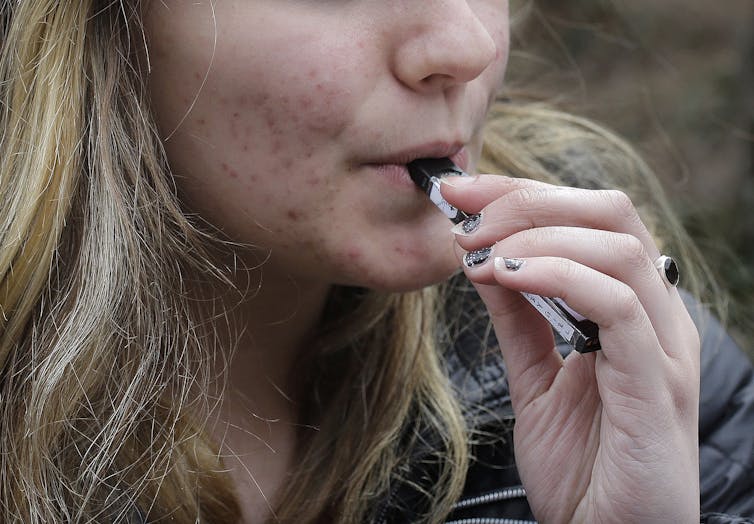Flavored e-cigarettes are fueling a dangerous increase in tobacco use
- Written by Leah Ranney, Director of Tobacco Prevention and Evaluation, University of North Carolina at Chapel Hill
An upsurge in e-cigarette use among middle and high school students occurred nationally between 2011 and 2018, with nearly 21 of every 100 high school students surveyed reporting e-cigarette use in the past 30 days, according to data from experts[1] at the U.S. Food and Drug Administration and the Centers for Disease Control and Prevention.
This trend is not by chance. Tobacco companies have spent billions of dollars annually on tobacco product advertisement, according to a Federal Trade Commission[2] report, and have used appealing packaging, culturally tailored brand names and advertisements that appear to target specific minorities and youth[3]. The colorful packaging and other strategies employed by the industry contribute to lower harm perceptions of these products and higher susceptibility to use among young people, according to researchers at the Center for Global Tobacco Control[4], Harvard School of Public Health and recent research on cigarillo packaging I conducted with my research team[5].
The FDA has announced[6] efforts to impose restrictions on flavored e-cigarettes and tobacco products. FDA recognizes the high rates of e-cigarette use among young people as a public health concern, and sees the urgent need for stricter product access.
Part of the agency’s plans call for restricting young people under the age of 18 from accessing flavored e-cigarettes via retail establishments and online websites. The FDA is seeking to have retailers move flavored e-cigarette products – excluding mint- and menthol-flavored products – to age-restricted areas in stores, and the FDA is proposing to heighten practices for age verification online. Agency officials have also called for removing e-cigarette products that are marketed to kids, among other measures[7].
And with the announcement that tobacco giant Altria paid US$13 billion for a 35 percent stake in Juul[8], the vaping company that uses flavors to market its e-cigarettes, the need to impose youth restrictions on flavored tobacco products takes on even more urgency.
Flavors change perception of risk
 Studies have suggested that flavoring tobacco and other smoking products leads to a perception that they are not as dangerous.
Bartlomiej Magierowski/Shutterstock.com[9]
Studies have suggested that flavoring tobacco and other smoking products leads to a perception that they are not as dangerous.
Bartlomiej Magierowski/Shutterstock.com[9]
Using a survey of young adults aged 18 to 26 recruited through an online crowd-sourcing tool, our group of researchers at the University of North Carolina School of Medicine found in a study published in PLOS ONE[10] that cigarillo pack flavor descriptors, such as grape and sweet, and colors such as pink and purple resulted in more favorable product perceptions among young adults. These pack attributes had a greater impact on how people who had never used cigarillos perceived product flavor and taste, compared to current cigarillo users, and people who have previously used them.
Further, we conducted a systematic review of all the scientific literature through April 2016 examining the impact of flavors on tobacco product perceptions and use behaviors. Important findings from this study, published in Tobacco Control,[11] suggested that flavored tobacco products have a strong appeal to youth and young adults because of the variety and availability of flavors; that flavors are a reason for use; and that flavors play a primary role in the use of e-cigarettes, little cigars and cigarillos, and hookah among younger people.
Two studies within our systematic review[12] found that packs containing flavor descriptions were more likely to be rated as having a lower health risk. Another study[13] of smokeless tobacco packs in the United States found that young adults were more likely than older adults to report that packs without flavor descriptions would contain more dangerous chemicals. Research is clear that flavored tobacco products have the potential to undermine progress gained to reduce youth tobacco use in the United States.
Importance of flavors in product use
 The smoking habits of young people are changing, with fewer using traditional cigarettes but more using vaping products.
Steven Senne/AP Photo[14]
The smoking habits of young people are changing, with fewer using traditional cigarettes but more using vaping products.
Steven Senne/AP Photo[14]
Research and survey data have shown that tobacco habits in this age group are changing. Youth cigarette smoking rates have declined substantially in recent years, with the National Youth Tobacco Survey[15] showing current use of cigarettes declining from 15.8 percent in 2011 to 7.6 percent in 2017 among high school students, according to data from experts at the CDC and FDA[16]. Meanwhile, e-cigarettes were the most commonly used product in that population in both middle and high school students in the survey data.
While traditional cigarette smoking has declined, patterns of dual (that is, use of two or more tobacco products in 30 days) and poly tobacco use (or the use of three or more tobacco products in 30 days) have emerged. In 2013, in a survey of North Carolina high school students, almost 30 percent reported use of any tobacco product, according to a study[17] from our team published in 2015 in the International Journal of Environmental Research and Public Health.
Within this sample, 19.1 percent used multiple tobacco products, compared with just 10.6 percent of the sample who were single product tobacco users. Youth predominately used cigarettes in combination with little cigars and cigarillos, or cigarettes with e-cigarettes. While there is substantial racial variation in multiple tobacco use patterns over time, in 2015, e-cigarettes were the most commonly used tobacco product among single product users across all racial groups, according to one of our studies published in Nicotine Tobacco Research[18].
Using data from the 2015 North Carolina Youth Tobacco Survey[19], we found in a study published earlier this year in Preventing Chronic Disease[20] that among survey respondents who were not susceptible to smoking cigarettes, 26 percent were at “high risk” for future e-cigarette use; 11.3 percent were classified as “susceptible” to using e-cigarettes; 10.4 percent had already tried an e-cigarette; and 4.5 percent were current e-cigarette users.
Using school enrollment figures, we estimated that 55,725 high school students in our home state of North Carolina were at low-risk of smoking cigarettes, but at high risk for e-cigarette use – which meant that they were susceptible to using e-cigarettes, had experimented with e-cigarettes, or currently used e-cigarettes. On a national scale, these findings are a considerable public health problem.
Specifically, high school students who believed that e-cigarettes and secondhand e-cigarette vapor were not harmful, or only somewhat harmful, were more likely to be susceptible to using e-cigarettes than students who thought e-cigarettes and secondhand e-cigarette vapor were harmful, our study found[21].
Moreover, exposure to e-cigarette vapor in indoor or outdoor public places was associated with greater odds of being susceptible to using e-cigarettes. This could mean that restricting secondhand exposure to vapor of e-cigarettes in public places, such as in school buildings, stores, restaurants, school grounds and parks, and mass media efforts to educate youth about the harms of e-cigarette use could be just as necessary as restricting access to these products.
We know[22] that adolescents and teenagers are very vulnerable to the influence of tobacco marketing. The use of appealing packages and flavors has a significant impact on young people, causing them to perceive these tobacco products as less harmful and, in turn, making them more likely to experiment and continue using tobacco products. As research on the impact of flavored tobacco products builds, I look forward to increased action to help prevent youth tobacco use.
References
- ^ data from experts (www.cdc.gov)
- ^ according to a Federal Trade Commission (www.ftc.gov)
- ^ that appear to target specific minorities and youth (www.sciencedirect.com)
- ^ researchers at the Center for Global Tobacco Control (tobaccocontrol.bmj.com)
- ^ recent research on cigarillo packaging I conducted with my research team (journals.plos.org)
- ^ has announced (www.fda.gov)
- ^ among other measures (www.nytimes.com)
- ^ 35 percent stake in Juul (www.wsj.com)
- ^ Bartlomiej Magierowski/Shutterstock.com (www.shutterstock.com)
- ^ published in PLOS ONE (journals.plos.org)
- ^ Tobacco Control, (tobaccocontrol.bmj.com)
- ^ systematic review (www.ncbi.nlm.nih.gov)
- ^ study (www.ncbi.nlm.nih.gov)
- ^ Steven Senne/AP Photo (www.apimages.com)
- ^ National Youth Tobacco Survey (www.cdc.gov)
- ^ according to data from experts at the CDC and FDA (www.cdc.gov)
- ^ study (www.ncbi.nlm.nih.gov)
- ^ according to one of our studies published in Nicotine Tobacco Research (doi.org)
- ^ North Carolina Youth Tobacco Survey (www.tobaccopreventionandcontrol.ncdhhs.gov)
- ^ Preventing Chronic Disease (www.cdc.gov)
- ^ our study found (www.cdc.gov)
- ^ We know (www.surgeongeneral.gov)
Authors: Leah Ranney, Director of Tobacco Prevention and Evaluation, University of North Carolina at Chapel Hill

